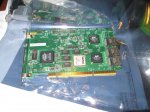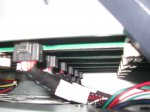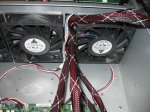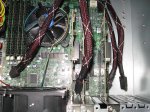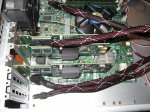Ok, so I started looking for a MOBO that will allow me to use all 24 HDDs through IBM ServeRAID M1015 controller cards (I would need a minimum of 3 (x8) PCI-E 2.0 interfaces onboard). I only found
two that might work out of all the searching that I did. If you know of a better MOBO that will work for my needs (
24 HDD's broken out in 6 sets of 4 using SFF-8087 connections).
I am not interested or able to use the onboard SATA connectors, as my case has backplanes with SFF-8087 connections. I'd rather not use a break out cable reversed.
Below is my search infomation, posted for your use as well as for me to easily find this information again wherever I am;
Supermicro Motherboards – Socket 1155 Intel Xeon E3-1200 v2 family with PCI-E 3.0 support. DO NOT choose a Proprietary form factor as it will not fit into your standard case.
X9SAE – (MBD-X9SAE-B)– 1 PCI-32bit, 2 (x4) PCI-E 2.0, 2 (1x) PCI-E 2.0, 1 (x16) PCI-e 3.0
2 SATA3 (6Gbps), 4 SATA2 (3Gbps)
X9SAE-V – 1 PCI-32 bit, 2 (x4) PCI-E 2.0, 2 (x1) PCI-E 2.0, 2 (x8) PCI-E 3.0 in x16
2 SATA3 (6Gbps), 4 SATA2 (3Gbps)
X9SCM-iiF – (MBD-X9SCM-iiF-B) - 2 (x8) PCI-E 3.0*** slots, 2 (x4) PCI-E 2.0 in x8 slots
4 SATA2 (3Gbps), 2 SATA3 (6Gbps)
THIS ONE IS SUPPOSED TO WORK FINE AS PER PREVIOUS POSTS
X9SCM-F – (MBD-X9SCM-F-B) - 2 (x8) PCI-E 3.0*** slots, 2 (x4) PCI-E 2.0 in x8 slots
4 SATA2 (3Gbps), 2 SATA3 (6Gbps)
CPU: Intel Xeon E3 1230 v2 (8M Cache, 3.3 GHz) (
$229.99)
RAM: 4x8GB DDR3, 1600MHz, ECC, CL11, 1.5V, Unbuffered, DIMM, 240-pin (
$266.99 for all)
IBM ServeRAID M1015 SAS/SATA Controller (46M0861) - 6 Gbps SAS 2.0 PCI Express 2.0 RAID controller (
$115.00 each – 3 required per server)
X9SCM – (MBD-X9SCM-B) - 2 (x8) PCI-E 3.0*** slots, 2 (x4) PCI-E 2.0 in x8 slots
4 SATA2 (3Gbps), 2 SATA3 (6Gbps)
X9SCL+-F – (MBD-X9SCL+-F-B) - 2 (x8) PCI-E 3.0*** in x8 slots, 1 (x4) PCI-E 2.0 in x8 slot
6x SATA2 (3Gbps)
X9SCL-F – (MBD-X9SCL-F-B) - 2 (x8) PCI-E 3.0*** in x8 slots, 1 (x4) PCI-E 2.0 in x8 slot
6x SATA2 (3Gbps)
X9SCL – (MBD-X9SCL-B) - 2 (x8) PCI-E 3.0*** in x8 slots, 1 (x4) PCI-E 2.0 in x8 slot
6x SATA2 (3Gbps)
X9SCA-F – (MBD-X9SCA-F-B) - 1 (x16) PCI-E 3.0***, 2 (x4) PCI-E 2.0 (in x8), 3 PCI 32-bit slots
4 SATA2 (3Gbps), 2 SATA3 (6Gbps)
X9SCA – (MBD-X9SCA-B) - 1 (x16) PCI-E 3.0***, 2 (x4) PCI-E 2.0 (in x8), 3 PCI 32-bit slots
4 SATA2 (3Gbps), 2 SATA3 (6Gbps)
X9SCI-LN4F – (MBD-X9SCI-LN4F-B) - 1 (x16) PCI-E 3.0*** slot, 1 PCI 32-bit slot
4 SATA2 (3Gbps), 2 SATA3 (6Gbps)
X9SCI-LN4 – (MBD-X9SCI-LN4-B) - 1 (x16) PCI-E 3.0*** slot, 1 PCI 32-bit slot
4 SATA2 (3Gbps), 2 SATA3 (6Gbps)
Tyan Motherboards – Socket 1155 Intel Xeon E3-1200 family
S5510 – (S5510GM3NR) - 1 PCI-E Gen.2 x4 slot, 2 PCI-E Gen.3 x8 slot (x8), 1 PCI-E Gen.2/Gen.3 x8 slot
2 SATA3 (6Gbps), 4 SATA2 (3Gbps)
S5512 – (S5512GM2NR) - 1 PCI-E Gen.2 x8 slot (x4), 2 PCI-E Gen.2 x1 slots, 1 PCI-E Gen.3 x16 slot (x8), 1 PCI-E x8 Gen.3 slot
2 SATA3 (6Gbps), 4 SATA2 (3Gbps)
S5512 – (S5512WGM2NR) - 2 PCI-E Gen.2 x1 slots, 1 PCI-E Gen.3 x16 slot (x8), 1 PCI-E x8 Gen.3 slot
8 SAS, 2 SATA3 (6Gbps), 4 SATA2 (3Gbps)
S5512 – (S5512GM4NR) - 1 PCI-E Gen.2 x8 slot (x4), 2 PCI-E Gen.2 x1 slots, 1 PCI-E Gen.3 x16 slot (x8), 1 PCI-E x8 Gen.3 slot
2 SATA3 (6Gbps), 4 SATA2 (3Gbps)
S5510-LE – (S5510G2NR-LE) - 2 PCI-E Gen.3 x8 slot (x8), 1 PCI-E Gen.3 x8 slot (x4)
6 SATA2 (3Gbps)
S5512-LE – (S5512G2NR-LE) - 2 PCI-E Gen.2 x1 slots, 1 PCI-E Gen.3 x16 slot (x8), 1 PCI-E x8 Gen.3 slot
6 SATA2 (3Gbps)
S5512-HE – (S5512G2NR-HE) - 1 PCI-E Gen.2 x8 slot (x4), 2 PCI-E Gen.2 x1 slots, 1 PCI-E Gen.3 x16 slot (x8), 1 PCI-E x8 Gen.3 slot
2 SATA3 (6Gbps), 4 SATA2 (3Gbps)
Intel Motherboards – Socket 1155 Intel Xeon E-1200 v2 family.
S1200BT – (S1200BTSR & S1200BTLR) - Up to 5 PCI-E 3.0
S1200KP – For embedded applications
IBM ServeRAID M1015 SAS/SATA Controller (46M0831) - 6 Gbps SAS 2.0 PCI Express 2.0 RAID controller
8 internal 6 Gbps SAS/SATA ports (2 x4 Internal SFF-8087 SAS or SATA connectors)
(x8) PCI-Express 2.0
Careful as to which type of bracket it comes with. Lots of them don’t come with any bracket. Otherwise, they typically come with a LOW PROFILE bracket. That’s great if you are putting it into a LOW PROFILE case. Otherwise it’s of no use. You will need a STANDARD PROFILE bracket if you are going to install it into any other type of case.
Amazon – (46M0831) ($217.00) –
External Site ($145.00) – Full height bracket included
Amazon – (46M0861) Full height bracket included ($115.00) –
External Site
Other part numbers (what is the difference between each part number???);
46M0862
68Y7366
SAS9220-8I
46C8933 – No bracket
Full Height Bracket – on Ebay ($10.00)
How to Cross Flash to IT mode
